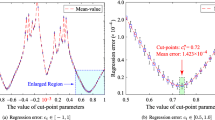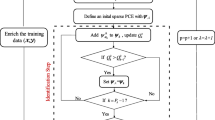Abstract
Simulating the higher-order statistical moments of response functions is a great challenge to research community in the filed of probabilistic analysis, and generally the polynomial surrogate model can be applied to evaluate these statistical moments. In this study, an analytical solution is developed for calculating the first four raw moments of response functions. Then, a novel criterion is proposed to choose the best analytical formulas that gives the most accurate values of response functions. The intrusive and non-intrusive PC expansion models are considered. Several applications are provided to demonstrate the accuracy and efficiency of the developed model, in which Monte Carlo methods are adopted as an exact criterion for comparison.




Similar content being viewed by others
References
Abramowitz, M., Stegum, I.E.: Handbook of Mathematical Functions. Dover, New York (1972)
Cai, C.H., Lu, Z.H., Xu, J., Zhao, Y.G.: Efficient algorithm for evaluation of statistical moments of performance functions. J. Eng. Mech. 145(1), 06018007 (2019)
Fan, W.L., Wei, J.H., Ang, A.H.-S., Li, Z.L.: Adaptive estimation of statistical moments of the responses of random systems. Probab. Eng. Mech. 43, 50–67 (2016)
Gerstner, T., Griebel, M.: Numerical integration using sparse grids. Numer. Algorithms. 18(3–4), 209–232 (1998)
Ghanem, R.: Ingredients for a general purpose stochastic finite elements implementation. Comput. Methods Appl. Mech. Eng. 168(1), 19–34 (1999)
Ghanem, R., Spanos, P.D.: Stochastic Finite Element: A Spectral Approach. Courier Dover Publications, Springer, New York, Mineola (2003)
He, J., Gao, S.B., Gong, J.: A sparse grid stochastic collocation method for structural reliability analysis. Struct. Saf. 51, 29–34 (2014)
Huang, X., Zhang, Y.: Reliability-sensitivity analysis using dimension reduction methods and saddlepoint approximations. Int. J. Numer. Meth. Eng. 93(8), 857–886 (2013)
Isaacson, E., Keller, H.B.: Analysis of Numerical Methods. Courier Corporation, New York (2012)
Liu, P.L., Der Kiureghian, A.: Multivariate distribution models with prescribed marginals and covariances. Probab. Eng. Mech. 1(2), 105–112 (1986)
Lu, Z.H., Cai, C.H., Xu, J., Zhao, Y.G.: Structural reliability analysis including correlated random variables based on third-moment transformation. J. Struct. Eng. 143(8), 04017067 (2017)
Ni, P.H., Xia, Y., Li, J., Hao, H.: Using polynomial chaos expansion for uncertainty and sensitivity analysis of bridge structures. Mech. Syst. Signal. Process. 119, 293–311 (2019)
Rahman, S., Xu, H.: A univariate dimension-reduction method for multi-dimensional integration in stochastic mechanics. Probab. Eng. Mech. 19(4), 393–408 (2004)
Rajan, A., Kuang, Y.C., Ooi, M.P.L., Demidenko, S.N.: Benchmark test distributions for expanded uncertainty evaluation algorithms. IEEE Trans. Instrum. Meas. 65(5), 1022–1034 (2016)
Rao, B.N., Chowdhury, R.: Factorized high dimensional model representation for structural reliability analysis. Eng. Comput. 25(8), 708–738 (2008)
Rosenblatt, M.: Remarks on a multivariate transformation. Ann. Math. Stat. 23(3), 470–472 (1952)
Sudret, B.: Global sensitivity analysis using polynomial chaos expansions. Reliab. Eng. Syst. Saf. 93, 964–979 (2008)
Sudret, B.: Adaptive Sparse Polynomial Chaos Expansion Based on Least Angle Regression. Academic Press Professional Inc (2011)
Wiener, N.: The homogeneous chaos. Am. J. Math. 60(4), 897–936 (1938)
Xu, J., Lu, Z.H.: Evaluation of statistical moments of performance functions based on efficient cubature formulation. J. Eng. Mech. 143(8), 06017007 (2017)
Zhang, T.: An improved high-moment method for reliability analysis. Struct. Multidiscip. Optim. 56, 1225–1232 (2017)
Qiang Zhang, Y.G Zhao, K Kristijan, L Xu. Simplified model for assessing progressive collapse resistance of reinforced concrete frames under an interior column loss. Engineering Structures, 2020, 215:110688.
Zhao, Y.G., Lu, Z.H.: Fourth-moment standardization for structural reliability assessment. J. Struct. Eng. 133(7), 916 (2007)
Zhao, Y.G., Ono, T.: New point estimates for probability moments. J. Eng. Mech. 126(4), 433–436 (2000a)
Zhao, Y.G., Ono, T.: Moment methods for structural reliability. Struct. Saf. 23(1), 47–75 (2000b)
Acknowledgements
The support is gratefully acknowledged.
Funding
The study is supported by the National Natural Science Foundation of China (Grant No. 51908009; 52008404).
Author information
Authors and Affiliations
Corresponding author
Ethics declarations
Conflict of interest
The authors declare that they have no conflict of interest.
Replication of results
All the necessary data to reproduce the results reported here are provided in Sect. 3. Readers can also contact us to get the codes by Email: qiang.zhangbuilding@gmail.com.
Additional information
Publisher's Note
Springer Nature remains neutral with regard to jurisdictional claims in published maps and institutional affiliations.
Appendices
Appendix 1: Equations for linearization coefficients
1.1 Jocobi polynomials
where the computational coefficients \(\tilde{B}_{n} ({\text{j}},{\text{k}})\) starting from
1.2 Hermite polynomials
1.3 Laguerre polynomials
Appendix 2. Efficient Cubature Formula I–III
2.1 Cubature Formula I
2.2 Cubature Formula II
2.3 Cubature Formula III
Rights and permissions
About this article
Cite this article
Zhang, Q., Xu, L. Evaluation of moments of performance functions based on polynomial chaos expansions. Int J Mech Mater Des 18, 395–405 (2022). https://doi.org/10.1007/s10999-021-09585-3
Received:
Accepted:
Published:
Issue Date:
DOI: https://doi.org/10.1007/s10999-021-09585-3




